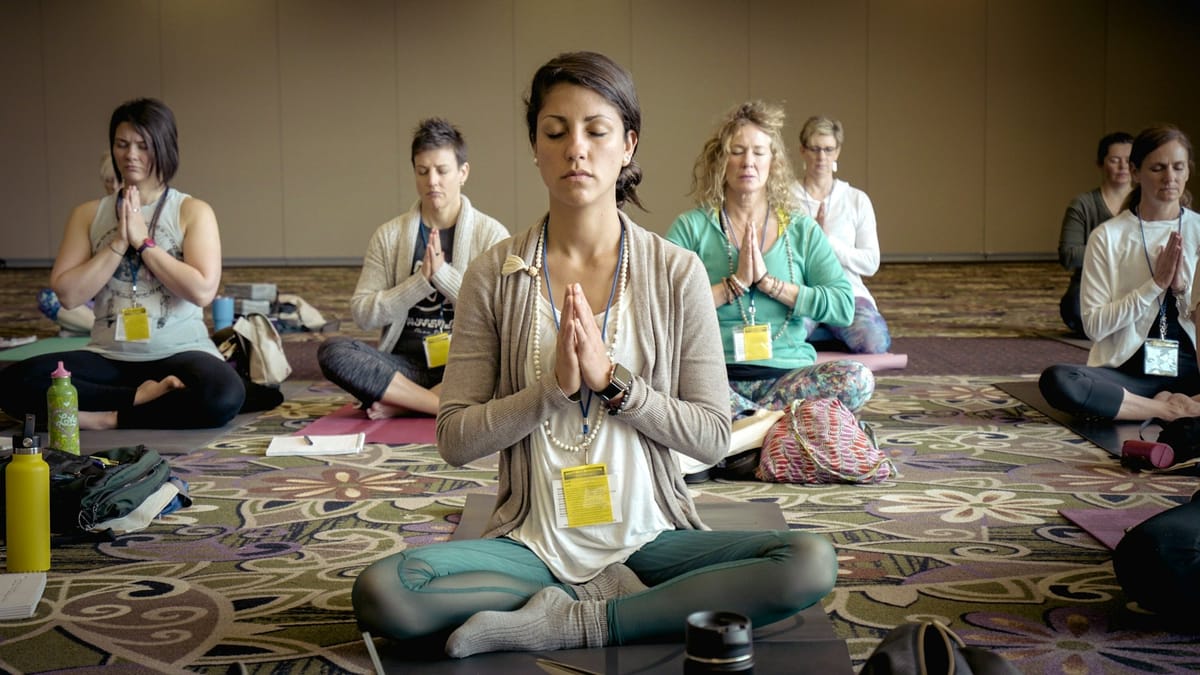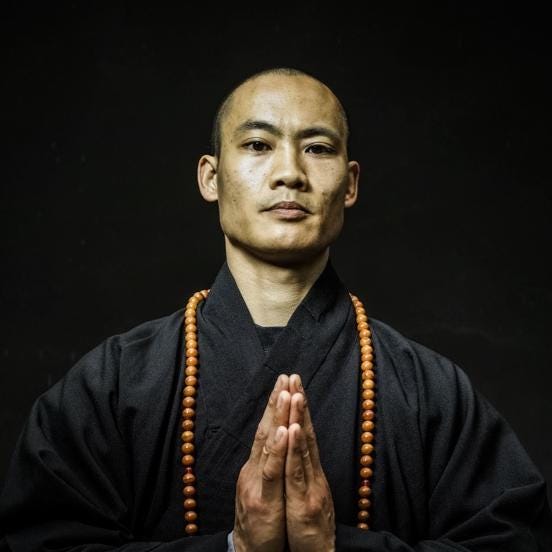Why Say Goodbye to the Pursuit of Happiness and Discover Peace
How you can learn that true contentment comes from within

The concept of saying goodbye to the pursuit of happiness and finding peace is about shifting our focus from chasing external goals and validation to cultivating inner well-being. It is about accepting that happiness is not something that can be achieved permanently, but rather a fleeting emotion that comes and goes.
When we are constantly chasing happiness, we are setting ourselves up for disappointment. We may achieve some of our goals, but we will never be able to fully satisfy our desire for happiness. This is because happiness is not something that comes from outside of us, but rather from within.
Peace, on the other hand, is a more sustainable state of being. It is not dependent on external circumstances or achievements. Peace comes from within, from a deep sense of acceptance and contentment.
When we say goodbye to the pursuit of happiness and focus on cultivating peace, we are not giving up on joy or pleasure. We are simply shifting our focus to a more sustainable and fulfilling way of living.
Here are some specific ways to find peace:
- Stop comparing yourself to others. One of the biggest obstacles to happiness is comparing ourselves to others. We see their successes and accomplishments and feel like we are not good enough. But the truth is, everyone is on their own unique journey. Comparing ourselves to others is only going to make us feel bad about ourselves.
- Focus on the present moment. Happiness is often fleeting because we are constantly dwelling on the past or worrying about the future. When we focus on the present moment, we are able to appreciate the good things in our lives and let go of negative thoughts.
- Be grateful for what you have. It is easy to focus on the things we don't have, but it is important to remember all the things we are grateful for. Gratitude can help us to appreciate the good things in our lives and cultivate a sense of peace.
- Practice mindfulness and meditation. Mindfulness and meditation are great ways to train our minds to focus on the present moment and let go of negative thoughts.
- Spend time in nature. Spending time in nature has been shown to reduce stress, improve mood, and boost feelings of well-being.
- Connect with loved ones. Strong social connections are essential for our well-being. Make time for the people you care about and nurture your relationships.
By saying goodbye to the pursuit of happiness and focusing on cultivating peace, we can create a more fulfilling and meaningful life.
Ancient Wisdom on Happiness and Peace

One of my favorite examples of peace within the realm of Western philosophy is exemplified by Shi Heng Yi.
Shi Heng Yi, belongs to the 35th Generation of Shaolin Masters and is the headmaster of the Shaolin Temple Europe located in Germany
In a 2016 interview, he speaks about the relationship between happiness sadness and inner peace.
The “Buddhist way“ as he refers to, helps to reach inner peace. All the circumstances around you are a reminder that nothing in this world is permanent, everything is changing, meaning that no matter how your life circumstances look like you will feel good.
if you have just lost your job, somebody just scratched your new car, in the lifestyle of Shaolin will help you to have some inner peace all these circumstances around you, it will help you to understand that nothing in this world is permanent everything is changing, so now the new car has aged a little bit faster than expected, changed from new to scratched, time just went a little bit faster.
The practice for yourself is, you need to learn and embrace change. Embrace will come if you want it or not but if you are able to go change, the faster you are able to adapt the fewer problems you will have. The more you hang on to the idea something should be and stay like it is, the more problems you will have because sticking to a fixed idea is not a concept of nature.
We generally say when things go well, we are happy and when things go bad we are unhappy, we rarely discuss the idea of being in peace. Shi Heng Yi explains how it's not possible to only stay happy or unhappy but to have peace means being okay in a state of happiness and unhappiness, feeling in peace or feeling balanced.
If you work for a long time under stress it's not a natural state, if you are for a long time relaxed, you sleep all day, is also not the natural way.
in Buddhism you're always in the middle, we don't live in extremes, the middle way is not going in between the extremes, the middle way is the way which is embracing both of the extremes.
As the Dalai Lama points out
“We are all the same as human beings and I am trying to educate people in understanding that the ultimate source of happiness is a warm heart and a calm mind. We need to pay more attention to peace of mind.”
Distinguishing Happiness from Inner Peace
Happiness and peace are two closely related concepts, but there are some key differences between them.
- Happiness involves feeling content, satisfied, and fulfilled, often linked to positive emotions like joy and pleasure. It's often fleeting, tied to external events, like achieving a goal or spending time with loved ones.
- Peace is inner tranquility and calm, associated with acceptance and balance. It's independent of external factors, achievable even during challenges.
Here is an overview that summarizes the key differences between happiness and peace:
Characteristics
Emotional state
- Happiness: Content, satisfied, fulfilled
- Peace: Tranquil, calm, serene
Associated emotions
- Happiness: Joy, excitement, pleasure
- Peace: Acceptance, serenity, balance
Dependence on external circumstances
- Happiness: Conditional
- Peace: Unconditional
Duration
- Happiness: Fleeting
- Peace: Long-lasting
Happiness is a state of feeling good, while peace is a state of being good. Happiness is often associated with positive emotions and external circumstances, while peace is associated with inner tranquility and balance. Happiness can be fleeting, while peace can be long-lasting.
It is important to note that happiness and peace are not mutually exclusive. We can experience both happiness and peace at the same time. For example, we may feel happy and peaceful while spending time with loved ones, enjoying nature, or practicing meditation.
Ultimately, happiness and peace are both important aspects of a well-lived life. By striving for both happiness and peace, we can create a more fulfilling and meaningful existence.

The Role of Biology and Environment
Happiness and peace are complex emotions that are influenced by a variety of factors, including hormones, environment, and our thoughts and beliefs. Let's delve into this further
Hormones
Certain hormones, like dopamine, serotonin, and oxytocin, are associated with happiness. They're released during positive emotions, enhancing our well-being. For instance, dopamine relates to reward and motivation, serotonin to mood, and oxytocin to social bonding.
Peace, distinct from hormones, is inner tranquility unaffected by external factors. While hormones impact various bodily functions, including mood, some indirect evidence suggests they can influence peace. For example, oxytocin fosters trust, empathy, and bonding, contributing to well-being.
Environment
Our environment greatly affects our happiness and peace. Physical surroundings, social interactions, and resource availability influence our well-being. A safe, supportive environment fosters happiness and peace, while a stressful or chaotic one hinders them.
Thoughts and beliefs
Our thoughts and beliefs shape our happiness and peace. Our interpretations and self-narratives significantly affect our emotions. A positive outlook and belief in our capabilities promote happiness and peace, while a negative perspective and self-doubt lead to unhappiness and anxiety.
What are some other factors that are thought to contribute to peace?
- A sense of purpose and meaning in life
- Strong social connections
- A positive outlook on life
- A regular practice of mindfulness or meditation
- Spending time in nature
- Engaging in activities that bring joy and satisfaction
Cultural Perspectives on Finding Fulfillment
Let's begin by examining the approaches in Eastern and Western cultures.
Eastern and Western cultures have different views on happiness and peace, and different approaches to achieving them.
Eastern cultures tend to focus on inner peace and contentment, rather than external achievement and success. They emphasize the importance of living in harmony with nature and with others. Some common practices that Eastern cultures use to achieve happiness and peace include:
- Meditation: Meditation is a practice of focusing the mind and calming the body. It has been shown to reduce stress, anxiety, and depression, and to improve mood and well-being.
- Metta meditation: Metta meditation, also known as loving-kindness meditation, is a practice focused on cultivating unconditional love and compassion. The word "metta" in Pali means benevolence, loving-kindness, friendliness and goodwill.
- Yoga: Yoga is a mind-body practice that combines physical postures, breathing exercises, and meditation. It has been shown to improve physical health, mental well-being, and overall quality of life.
- Daoism: Daoism is a philosophical and religious tradition that emphasizes the importance of living in harmony with nature and with the Tao, or the universal force that governs all things. Daoists believe that happiness and peace can be achieved by following the Tao and living a simple and natural life.
- Buddhism: Buddhism is a religion and philosophy that teaches that the path to happiness and enlightenment lies in following the Eightfold Path, which includes ethical conduct, mental discipline, and wisdom. Buddhists believe that happiness can be achieved by letting go of attachments and desires, and by cultivating compassion and wisdom.
Western cultures tend to focus on external achievement and success as a means to happiness. They emphasize the importance of individual freedom, material possessions, and social status. Some common practices that Western cultures use to achieve happiness and peace include:
- Pursuing goals and ambitions: Western cultures often encourage people to set goals and work hard to achieve them. This can lead to a sense of accomplishment and satisfaction, which can contribute to happiness.
- Having a strong social network: Western cultures value strong social connections. Having close friends and family members can provide support and companionship, which can contribute to happiness and well-being.
- Volunteering and helping others: Volunteering and helping others can give people a sense of purpose and meaning in life, which can contribute to happiness and peace.
- Enjoying leisure activities: Western cultures value leisure time and encourage people to engage in activities that bring them joy and relaxation. This can help people to reduce stress and improve their overall well-being.
Both Eastern and Western cultures exhibit diversity, with individuals defying easy categorization. Commonalities exist too; both emphasize strong social bonds and nature's significance.

Integrating Eastern and Western Approaches
Eastern approaches highlight the challenge of releasing attachments and desires, while Western approaches emphasize individual freedom. Combining both has value.
By uniting Eastern focus on inner peace with Western drive for goals, we achieve a balanced well-being approach. Meditation and goal setting, for instance, can coexist, promoting both inner peace and external success.
Incorporating Buddhist principles like metta meditation, which fosters unconditional love and compassion, can be valuable. It aligns with Western emphasis on strong social connections and helping others. Self-compassion paves the way for compassion toward others, fostering shared humanity and overcoming ill-will.
Here are some specific examples of how we can combine Eastern and Western approaches to happiness and peace:
- Meditation for goal setting: We can use meditation to clear our minds and focus on our goals. This can help us to make more mindful and intentional decisions about our goals.
- Yoga for stress relief: We can use yoga to reduce stress and anxiety. This can help us to create a more peaceful and relaxed state of mind.
- Daoism for living in harmony with others: We can use Taoist principles to guide our interactions with others. This can help us to create more harmonious and supportive relationships.
- Buddhism for compassion and forgiveness: We can use Buddhist principles to cultivate compassion and forgiveness. This can help us to live a more peaceful and fulfilling life.
Practical Tools and Resources
Meditation
- Insight Timer: A free app with a vast library of guided meditations for all levels of experience.
- Calm: A popular app with a variety of guided meditations, sleep stories, and music for relaxation.
- Headspace: Another popular app with a focus on mindfulness meditation.
- The Mindful Geek: A website with articles, videos, and podcasts on meditation and mindfulness.
- The Mindfulness Bell: A website with a daily meditation practice and a forum for discussion.
Yoga
- Yoga with Adriene: A YouTube channel with free yoga videos for all levels of experience.
- Down Dog: A popular app with a variety of yoga classes to choose from.
- Yoga International: A website with a variety of yoga classes, workshops, and articles.
- The Yoga Sutras: A classic text on yoga philosophy and practice.
- B.K.S. Iyengar's Light on Yoga: A comprehensive guide to the Iyengar yoga tradition.
Daoism
- The Tao Te Ching: A classic text on Daoist philosophy.
- Zhuangzi: Another classic text on Daoist philosophy.
- Stephen Mitchell's translation of the Tao Te Ching: A popular and accessible translation of the Tao Te Ching.
- Robert M. Pirsig's book Zen and the Art of Motorcycle Maintenance: A novel that explores Daoist philosophy and practice.
- Alan Watts' lectures on Daoism: A series of lectures that provide a clear and concise introduction to Daoist philosophy.
Buddhism
- The Dhammapada: A collection of Buddhist teachings.
- The Heart Sutra: A short but powerful Buddhist text.
- Jack Kornfield's book The Path of Serenity: A practical guide to Buddhist meditation.
- Pema Chodron's book When Things Fall Apart: A compassionate and wise guide to dealing with difficult emotions.
- Thich Nhat Hanh's book Peace Is Every Step: A guide to living a mindful and compassionate life.
Metta Meditation
- Loving-Kindness Meditation: Strengthen feelings of kindness and connection toward others.
- Metta - Loving Kindness Meditation: What Is Loving-Kindness Meditation?
Pursuing goals and ambitions
- James Clear's book Atomic Habits: A practical guide to building good habits and breaking bad ones.
- Cal Newport's book Deep Work: A book about the importance of focused work in a distracted world.
- David Allen's book Getting Things Done: A productivity system that helps you to organize your work and get things done.
- The Tim Ferriss Show: A podcast that interviews successful people about their habits and routines.
- Seth Godin's blog: A blog about marketing, creativity, and entrepreneurship.
Having a strong social network
- Susan Cain's book Quiet: A book about the power of introverts and the importance of social connection.
- Brené Brown's book The Gifts of Imperfection: A book about the importance of vulnerability and authenticity in relationships.
- Barry Schwartz's book The Paradox of Choice: A book about the challenges of decision-making in a world of too many options.
- Gretchen Rubin's blog: A blog about happiness, habits, and human nature.
- The Friendship Formula: A podcast about friendship and social connection.
Volunteering and helping others
- VolunteerMatch: A website that connects volunteers with opportunities in their communities.
- HandsOn Connect: A website that connects volunteers with opportunities in their communities.
- Idealist: A website that connects volunteers with opportunities around the world.
- The Greater Good Science Center: A website that publishes research on the benefits of compassion and altruism.
- The Prosocial World: A podcast about the science of prosocial behavior.
Enjoying leisure activities
- Project Time Off: A website that promotes the importance of vacation time and provides resources for finding affordable vacation options.
- The Art of Manliness: A website with articles and videos on a variety of topics, including men's health, fitness, and lifestyle.
- The Art of Living: A website with articles and videos on a variety of topics, including personal growth, relationships, and well-being.
- The Minimalists: A website and podcast about minimalism and intentional living.
- The Balanced Life: A podcast about finding balance in all areas of your life.
These are just a few of the many resources available for learning about and practicing Eastern and Western approaches to happiness and peace. By exploring different resources and finding what works best for you, you can create a more holistic and balanced approach to well-being.
Key Lessons and Takeaways
- Happiness is fleeting and conditional, while inner peace is more lasting and comes from within. It's important to cultivate peace rather than chase happiness.
- There are biological factors like hormones that influence happiness, but peace stems more from our inner state of mind. Our thoughts, beliefs, and environment also play a role.
- Eastern philosophies emphasize inner harmony, letting go of desires, and practices like meditation. Western approaches focus more on ambition, success, and social connections.
- Combining the best of Eastern and Western practices allows for a balanced approach - inner tranquility plus external achievement.
- Daily habits like mindfulness, yoga, and time in nature are practical ways to calm the mind and body. Letting go of expectations and having self-compassion help too.
- There are many great resources available to learn about meditation, yoga, Buddhist ideas, goal-setting, social connection, volunteering, leisure activities and more.
- The journey requires openness, patience and experimenting with different perspectives. Integrating various philosophies can lead to greater fulfillment.
- Overall, the main takeaway is that true peace comes from within. By focusing less on chasing happiness and more on inner well-being, we can live with greater meaning.
- The key is finding balance - accepting what we have in the present moment while still working toward our goals and embracing positive emotions when they arise. With this balanced approach, we create space for both peace and happiness in our lives.
Thank you for reading this post! If you found it helpful or informative, please consider sharing a 7 day free trial with your friends, family, or colleagues who might benefit from it.
Your support helps me reach more people and spread awareness on important topics like this. Together, we can make a difference!




